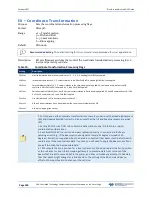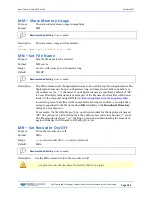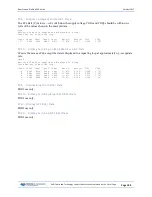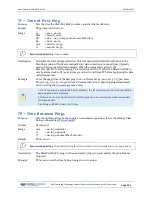
October 2017
RiverPro and RioPro ADCP Guide
Page 112
EAR-Controlled Technology Subject to Restrictions Contained on the Cover Page.
PT3
This test displays receive path characteristics. The test result is given as eight nibbles (1 nibble = 4 bits).
Each nibble represents the result for a particular beam (most significant nibble = beam 1, least significant
nibble = beam 8) (four beam RiverPro/RioPro systems utilize the four most significant nibbles). In this
example, TRDI only describes which bit is set for beam 2 for a given failure type.
Sending PT3 or PT3 0 (default) displays the Hard Limited output. Sending PT3 1 displays the 8-bit sam-
pling
Linear
output.
This test has three parts:
•
Correlation Magnitude –
The RiverPro/RioPro pings without transmitting and displays the result of
an autocorrelation function performed over 14 lag periods (only the first 8 are displayed). Ideally,
there should be high correlation at near-zero lags, and then lower correlations as the lag number
increases. For the PT3 or PT3 0 command, values above 500 for lag greater than two indicates
interference or hardware problems. For the PT3 2 command, values above 10 for lags greater than
zero indicate interference or a hardware problem.
•
Sin / Cos Duty Cycle –
For the PT3 or PT3 0 commands, this shows the percentage of samples that
are in phase (cos) or 90 degrees out of phase (sin) with the carrier signal. The total of the sin and
cos duty cycles should be close to 100 and both values should be in the range 45-55. If either the
sin or cos duty cycles are out of this range indicates interference or a hardware problem.
•
RSSI Noise Floor –
For the PT 3 or PT 3 0 commands and PT 3 1 command, this shows the RSSI
value at various gains and bandwidths. These values give the noise floor for RSSI. Values above 55
for the H-Gain N-BW noise floor indicate a possible interference or a hardware problem. Values
below 45 indicate that the RSSI needs to be recalibrated at the factory. PT3 2 runs the same test
as PT3 1 using Linear data but reports SNR instead of correlation.
>pt3 0
Receive Path Test (Hard Limited):
Correlation Magnitude:
H-Gain W-BW L-Gain W-BW
Lag Bm1 Bm2 Bm3 Bm4 Bm1 Bm2 Bm3 Bm4
0 1000 1000 1000 1000 1000 1000 1000 1000
1 707 726 749 732 833 825 822 817
2 112 169 348 214 515 494 493 478
3 345 285 216 256 97 64 81 56
4 181 142 36 113 22 16 14 16
5 155 112 39 97 5 10 20 3
6 33 16 24 22 2 8 11 12
7 38 5 54 12 23 11 12 13
H-Gain N-BW L-Gain N-BW
Lag Bm1 Bm2 Bm3 Bm4 Bm1 Bm2 Bm3 Bm4
0 1000 1000 1000 1000 1000 1000 1000 1000
1 822 861 860 856 833 826 825 825
2 474 572 572 556 503 496 490 487
3 41 132 156 110 68 67 59 52
4 72 13 89 20 12 6 18 10
5 57 22 77 17 13 15 21 13
6 57 31 75 21 4 6 7 3
7 55 28 68 31 11 5 2 5
H-Gain W-BW L-Gain W-BW H-Gain N-BW L-Gain N-BW
Bm1 Bm2 Bm3 Bm4 Bm1 Bm2 Bm3 Bm4 Bm1 Bm2 Bm3 Bm4 Bm1 Bm2 Bm3 Bm4
Sin Duty Cycle (percent)
48 47 51 54 51 50 49 50 48 47 52 55 50 50 51 49
Cos Duty Cycle (percent)
50 49 49 53 49 50 49 49 51 47 51 54 51 49 50 52
RSSI Noise Floor (counts)
53 51 48 49 43 45 45 44 40 41 39 39 35 38 38 36
>pt3 1
Receive Path Test (Linear):
Correlation Magnitude:
















































